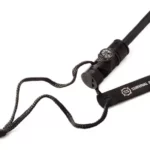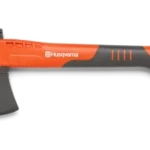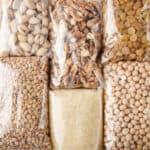
Did you know that about half of Americans aren’t prepared with an emergency food supply? This blog post will guide you on how to build a prepping pantry using everyday grocery store items.
Key Takeaways
- A prepping pantry is essential for preparedness during emergencies and disasters, providing peace of mind and cost savings.
- When building a prepping pantry, set a budget, purchase shelf-stable and non-perishable foods, consider dietary restrictions and preferences, maintain a variety of food categories, and know the shelf life of different foods.
- Essential items to stock in your prepping pantry include canned goods, dried goods, jarred items, freeze-dried food, nuts and seeds, and shelf-stable milk alternatives.
- Grains like rice and oats are essential staples, also beans and legumes for protein. Include canned meats like chicken or fish for added sustenance. Remember vitamin supplements to ensure proper nutrition during emergencies.
Let’s dig in, as nobody should go hungry when emergencies strike!
Table of Contents
Reasons To Start A Prepping Pantry
Starting a prepping pantry is essential for preparedness in emergencies and disasters, provides peace of mind, and helps save costs.
Preparedness For Emergencies And Disasters
Building a prepper pantry is critical in preparing for emergencies and disasters. Emergencies can strike unexpectedly, leaving families without access to food supplies or basic amenities for days, weeks, or longer.
Having your own stash of essential food allows you to be self-sufficient during such times. With this approach, you are securing nutrition and independence from public resources that may quickly become scarce in a crisis.
It’s about taking control of your sustenance needs before any potential upheavals that could disrupt the supply chain, ultimately leading to less worry when disaster strikes. By stocking up on non-perishable foods already consumed daily and long-lasting emergency-specific items, you tackle one significant part of survival during adversities head-on – ensuring consistent access to food regardless of circumstances.
Peace Of Mind
A well-stocked prepper pantry prepares you for sudden food shortages and bestows unparalleled peace of mind. Emergencies or disasters, like natural calamities or even job loss, often hit unannounced, and having a buffer in such times can be immensely comforting.
The assurance that your family will continue to have access to nutritious meals even during crises is priceless. As the saying goes, “Better safe than sorry.” Prepping your pantry with shelf-stable food items extends beyond mere convenience; it acts as a safety net amidst uncertainty.
Your stocked pantry stands ready, packed with nutrition to sustain you through challenging times. It includes non-food items, too, which might come in handy for unforeseen situations – all contributing to this overall sense of security.
Building a working prepper pantry isn’t just about stocking up on canned chicken and dry goods, it’s cultivating reassurance: knowing that no matter what comes your way, you’re prepared to face it head-on.
Cost Savings
Building a prepper pantry brings significant cost savings over time. Taking the initiative to stock your pantry with non-perishable food items when prices are lower than during peak times or in an emergency considerably reduces expenses.
This approach utilizes the power of bulk buying, often resulting in decreased unit pricing. It also ensures you’re less affected by price surges due to supply chain disruptions or inflation.
By focusing on stocking up on shelf-stable foods that your family normally eats, you further maximize value as no food goes wasted. Furthermore, maintaining an ample food supply minimizes trips to local grocery stores, thus saving fuel costs and precious time that could be spent productively elsewhere.
A well-organized system like FIFO (First In, First Out) helps manage expiration dates effectively, reducing loss through spoilage.
Guidelines For Building A Prepping Pantry
When building a prepping pantry, it is vital to set a budget, purchase shelf-stable and non-perishable foods, consider dietary restrictions and preferences, maintain a variety of food categories, and know the shelf life of different foods.
Set A Budget
Setting a budget is essential to start building your prepping pantry. This will help you prioritize your purchases and ensure you are making the most of your financial resources. By determining how much you can afford to spend, you can make informed decisions about which food items to buy and what quantities.
A budget also helps prevent overspending or purchasing unnecessary items. So before embarking on your prepping journey, take some time to establish a realistic budget that aligns with your financial situation and goals for building a well-stocked pantry.
By doing so, you’ll be able to confidently navigate the supermarket aisles and make strategic purchases for your prepper pantry’s success.
See our Foods That Last a Long Time for more information.
Purchase Shelf-stable And Non-perishable Foods
Stocking up on shelf-stable and non-perishable foods is crucial when building a prepping pantry. These items can be safely stored at room temperature and have a long shelf life, making them ideal for emergencies. Here are some essential foods to consider adding to your prepping pantry:
- Canned goods: Stock up on canned vegetables, fruits, meats (such as tuna or chicken), and soups. These items are convenient and can provide valuable nutrients during an emergency. Number 10 cans are a cost-effective solution.
- Dried goods: Invest in dried beans, rice, pasta, oats, and other grains. These foods are versatile, have a long shelf life, and can be used in various recipes.
- Jarred items: Consider storing peanut butter, jelly/jam, honey, and pickles. These condiments can add flavor to your meals and offer a sense of normalcy during challenging times.
- Freeze-dried food: While more expensive than other options, freeze-dried fruits, vegetables, and meats retain their nutritional value and have an extended shelf life. They can be rehydrated with water when needed.
- Nuts and seeds: High in protein and healthy fats, nuts and seeds provide a great source of nutrition. Look for vacuum-sealed bags or jars to keep them fresh for extended periods.
- Shelf-stable milk alternatives: If you consume dairy alternatives like almond or soy milk, consider purchasing the non-refrigerated versions in cartons or tetra paks.
Consider Dietary Restrictions And Preferences
When building your prepping pantry, it’s crucial to consider any dietary restrictions and preferences you or your family may have. Whether it’s allergies, intolerances, or specific dietary choices, stocking your pantry with food that meets everyone’s needs is essential for long-term preparedness.
Make sure to select a variety of foods that cater to different dietary requirements while providing the necessary nutrients for optimal health. By considering individual preferences and restrictions, you can ensure that your prepping pantry remains versatile and well-suited for any situation.
Maintain A Variety Of Food Categories
To ensure a well-rounded prepping pantry, it is essential to maintain a variety of food categories. This includes stocking up on grains, beans, and legumes for long-lasting carbohydrates and protein sources.
Remember meats and proteins like canned chicken or tuna for added sustenance. Canned and jarred items such as fruits, vegetables, soups, and sauces provide necessary vitamins and flavors.
Fats like olive oil or peanut butter offer calorie-dense options that can keep you energized in times of need. Dry goods such as pasta, rice, flour, and sugar are versatile staples that can be used in various recipes.
Know The Shelf Life Of Different Foods
Preppers need to know the shelf life of different foods to stock their pantry correctly. Here are some essential facts to keep in mind:
- Dry shelf-stable foods can be safely eaten indefinitely as long as they have remained dry and have not attracted pests. This includes items like rice, pasta, beans, and dried fruits.
- Canned goods typically have a shelf life ranging from 2 to 5 years, depending on the product. Make sure to regularly check expiration dates and rotate your stock accordingly.
- Some freeze-dried and dehydrated foods can last even longer, with a shelf life of up to 25 years if stored properly. These options are great for long-term storage.
- Fats and oils have varying shelf lives depending on the type. For example, vegetable oils can last up to 2 years, while olive oil can last up to 4 years.
- It’s also important to consider the shelf life of non-food items that may be part of your prepping pantry, such as batteries or first aid supplies.
Medicines also are part of prepping, and shelf life is a concern for those too; see Do Epsom Salts Expire?
Stocking Your Prepping Pantry
Stock your prepping pantry with a variety of food items, including grains, beans, legumes, meats and proteins, canned and jarred items, fats, dry goods, frozen foods, water, and beverages.
Grains, Beans, And Legumes
Grains, beans, and legumes are the backbone of a well-stocked prepping pantry. These versatile items provide essential nutrients like protein and fiber, making them an excellent choice for maintaining a balanced diet during any emergency or survival situation.
Regarding grains, options like rice, oats, quinoa, and pasta should be part of your stockpile as they have a long shelf life and can be used in various meals. Additionally, stocking up on different types of beans such as black beans, garbanzo beans (chickpeas), and azuki beans ensures you have protein-rich foods with a long shelf life readily available.
Add legumes like lentils and split peas to diversify your food options further. With their cost-effectiveness and availability year-round at supermarkets, grains, beans, and legumes are reliable choices for building your prepping pantry that will keep you nourished in times of need.
Meats And Proteins
Including meats and proteins in your prepping pantry is crucial for a well-rounded and nutritious food supply. Canned proteins, such as chicken and fish, are affordable options with a long shelf life, making them ideal choices for stockpiling.
These canned meats can be used in various dishes like pasta, casserole, stew, salads, or sandwiches to provide additional protein. It’s also a good idea to store canned and dried meat as they are considered the best prepper proteins for long-term storage.
Remember to include vitamin, mineral, and protein supplements in your stockpile to ensure adequate nutrition during emergencies or disasters. Including these meat and protein sources in your prepping pantry ensures that essential nutrients are available even when access to fresh meat may be limited.
Canned And Jarred Items
Canned and jarred items are essential staples for building a well-stocked prepper pantry. These shelf-stable foods have a long shelf life, making them perfect for emergencies and disasters. Stock up on canned vegetables, fruits, soups, and proteins like chicken or tuna.
Remember condiments like tomato sauce and salsa, as they can add flavor to your meals. Jarred goods like pickles and olives also provide variety to your pantry. Always check the expiration dates when buying canned and jarred items to ensure freshness.
By including these items in your prepper pantry, you’ll have a reliable source of nourishment during challenging times.
Fats
Fats are often overlooked when stocking a prepping pantry, but they are crucial to your food stores. Good fats need to be included in your storage because fats are something we use daily.
However, shelf-life can be tricky with fats, so it’s important to consider this aspect when building your pantry. There may also be dietary restrictions to follow when stocking up on fats, so do your best to incorporate options that align with those requirements.
Canned foods can be an excellent choice for adding fats to your prepper pantry, including vegetables, fruits, fish, and preserved meats. So remember to include these essential fat sources in your food stores for optimal nutrition and variety during emergencies or disasters.
Dry Goods
Dry goods are a crucial component of any well-stocked prepper pantry. These non-perishable food items, including salted, smoked, and cured meats, have a long shelf life and can provide sustenance during an emergency or crisis.
Grains, such as rice, oats, and quinoa, should be at the top of your list as they are affordable, versatile, and nutritious. Additionally, stocking up on dried beans and legumes is essential for their protein content and extended shelf life.
Other dry goods include pasta, flour, sugar, salt, and spices. These items can be stored in a cool and dry place to maintain quality over time. Including various dry goods in your prepper pantry ensures you have the necessary ingredients to create nutritious meals even when access to fresh produce is limited.
Frozen Foods
Frozen foods are an essential addition to any prepping pantry. Not only do they provide a convenient and easy meal solution, but they also offer long-lasting food options during emergencies.
Stocking up on frozen fruits, vegetables, and meats (cooked or raw) is highly recommended for your freezer. The best part is that frozen foods give you a broader selection of ingredients to work with when preparing meals.
So go ahead and add some frozen goodness to your prepping pantry – just be prepared in case the power goes out. If you do lose power, you may need to know How to Start a Fire in a Fire Pit for cooking.
Water And Beverages
Water and beverages are essential components to include in your prepping pantry. It is crucial to have an adequate supply of clean drinking water for both hydration and various emergencies.
Aim to store at least one gallon of water per person daily, with a recommended supply for two weeks. In addition to water, consider stocking up on bottled or canned beverages like juices and sports drinks that can provide extra hydration options during emergencies.
Remember to regularly check the expiration dates on your stored water and rotate it out as needed to ensure freshness and safety.
As an emergency backup solution, you should know How To Purify Water.
Action Plan: Gradually Building Your Prepper Pantry on a Budget
Building up your emergency food supplies doesn’t have to break the bank. With some strategic planning and consistent effort, you can stock your prepper pantry over time, even on a tight budget. Here are some practical tips:
- Set a weekly budget
Decide how much you can comfortably allocate to your prepper pantry each week, even if it’s just $5-20. Consistently setting aside these funds will add up over time. For example, $20 per week amounts to over $1000 worth of extra food and supplies after a year. - Buy a few extra items each grocery trip
When doing your regular shopping, toss a few extra shelf-stable items in your cart. Rice, beans, canned goods, and other basics are inexpensive and have long shelf lives. Buying 2-3 extra cans of food per week is hardly noticeable on the grocery bill but really builds up the pantry. - Take advantage of sales
Stock up on non-perishables when they go on sale. If canned vegetables are 50% off, buy a case instead of just one or two cans. Acquiring your prepper food supply at a discount makes the most of your limited funds. - Focus on cheap, versatile staples first
Prioritize stocking up on low-cost, filling foods that can be used in many ways. Rice, beans, pasta, and oats provide a lot of calories and nutrition for the price. Once you have a good base, then add in more variety. - Buy in bulk when possible
Purchasing rice, beans, flour, and other staples in bulk quantities is often more cost-effective. If you don’t have the budget for a 50lb bag, consider splitting it with another prepper family. You can also save by buying bulk sizes of items like peanut butter or coffee. - Grow some of your own food
Even a small garden can supplement your pantry with fresh produce. Grow nutrient-packed, calorie-dense foods like potatoes, winter squash, and dry beans. Home-grown food is much cheaper than store-bought. - Use a vacuum sealer
Investing in a vacuum sealer allows you to preserve dry goods in airtight packaging yourself, rather than paying for more expensive pre-packaged survival food. You can seal your own rice, beans, pasta, etc in jars or mylar bags.
Remember, building your prepper pantry is a marathon, not a sprint. By consistently using these strategies, you’ll see your food stores steadily grow without putting undue stress on your wallet. Stay focused on your preparedness goals and don’t get discouraged – over time, you’ll build an impressive stockpile $20 at a time.
Prepping Pantry Organization And Maintenance
Properly store and rotate your pantry items to ensure their freshness and longevity. Keep track of your inventory, regularly reviewing and replenishing supplies as needed. Develop meal plans and recipes that utilize pantry items. Stay informed on food safety practices for optimal organization and maintenance of your prepping pantry.
Proper Storage And Rotation
Proper storage and rotation are essential for maintaining a well-organized prepping pantry. Here’s how you can ensure your food stays fresh and ready to use:
- Store food in a cool and dry location to maximize shelf life.
- Use sealed containers, such as mylar or vacuum-sealed bags, to protect against moisture and pests.
- Label each item with the purchase date or expiration date for easy tracking.
- Rotate your food supply by placing newly purchased items at the back of the pantry and bringing older items to the front.
- Regularly check the condition of your stored food, including cans, for any signs of damage or bulging.
- Keep an inventory list of everything in your pantry, noting quantities and expiration dates.
- For easier access, consider organizing your pantry based on food categories (e.g., grains, proteins, canned goods).
- Develop meal plans incorporating items from your prepping pantry to ensure they are used regularly.
- Stay informed about proper food safety practices, such as storing certain items in refrigeration if required.
- Periodically review and replenish your supplies to maintain a well-stocked pantry.
Keeping Inventory
To maintain an efficient and well-organized prepping pantry, keeping a detailed inventory of your supplies is crucial. By regularly taking stock of what you have on hand, you can ensure that nothing goes to waste and that you always know what items need replenishing.
Keeping track of expiration dates and rotating items will help prevent any food from going bad or becoming unusable. Additionally, having an accurate inventory allows you to quickly assess what you need in case of an emergency or unexpected event.
By staying proactive and organized with your inventory management, you can ensure that your prepping pantry remains fully stocked with the necessary items for any situation.
Regularly Reviewing And Replenishing Supplies
Regularly reviewing and replenishing supplies is crucial for maintaining an organized and well-stocked prepping pantry. Here’s why:
- Keep inventory updated: Regularly reviewing your supplies allows you to track what you have on hand. This information helps you avoid duplicate purchases and keep your pantry stocked with the necessary items.
- Prevent expiration: By regularly checking the expiration dates of your stored food, you can identify products that are nearing their expiration date. This practice enables you to consume or replace those items before they go bad and maintain a fresh food supply.
- Rotate stock: A key aspect of maintaining a prepping pantry is practicing proper stock rotation. Consuming and replacing the oldest items with new ones ensures your food supply stays fresh and usable.
- Adapt to changing needs: Your dietary preferences or restrictions might change over time, so reviewing and updating your stores is essential. This allows you to have suitable food options for everyone in your household.
- Stay prepared for emergencies: Regularly replenishing supplies ensures that your prepping pantry remains well-stocked even after using items during emergencies or unexpected situations. It helps ensure a continuous food supply for yourself and your loved ones.
- Take advantage of sales: By reviewing your supplies regularly, you can identify any shortage or low stock situations beforehand, allowing you to take advantage of sales or discounts when purchasing replacement items.
- Reassess priorities: Regular reviews will enable you to reassess your prepping pantry based on potential risks or changing circumstances. Doing this helps ensure your stockpile aligns with current needs and possible future scenarios.
Developing Meal Plans And Recipes Using Pantry Items
- Make sandwiches or salads using canned meats such as chicken, tuna, and salmon.
- Make hearty soups using canned vegetables, beans, and broth.
- Create pasta dishes using canned tomatoes and jarred sauces.
- Whip up stir-fry dishes using canned vegetables and shelf-stable proteins like tofu or canned chicken.
- Prepare chili or stews using canned beans, tomatoes, and spices.
- Make tacos or burritos using canned beans, salsa, and tortillas.
- Create casseroles using canned meats, vegetables, and cream soups.
- Bake bread or muffins using shelf-stable baking ingredients like flour, sugar, and yeast.
- Make desserts like fruit crisps or cobblers using canned fruits.
- Make homemade granola bars or energy balls using dried fruit and nuts from your pantry.
Staying Informed And Updated On Food Safety Practices
To ensure the safety of your prepping pantry, it’s important to stay informed and updated on food safety practices. This means understanding proper storage and rotation techniques and keeping an inventory of your supplies.
The Indy Hunger Network has created a manual of best practices for food pantries, providing guidance to hunger relief providers.
Penn State Extension offers a wealth of resources on home food safety, stressing the importance of keeping foods safe for healthy eating.
Calculating Your Prepper Pantry Food Storage Goals
When building your prepper pantry, it’s important to have a clear idea of how much food you actually need to store. While there’s no one-size-fits-all answer, here are some general guidelines based on a typical household of 4 people.
72-Hour Emergency Supply
A great starting goal is to build a 72-hour supply of non-perishable food that would get your family through a short-term emergency like a severe storm or power outage. For a family of 4, this means stocking:
- 12 gallons of water (1 gallon per person per day)
- Approximately 28 meals (2 meals per person per day, plus some snacks)
Focus on items that are easy to prepare without power like granola bars, canned goods, and shelf-stable microwavable meals.
1-Month Supply
The next milestone is a 1-month supply. This would provide a safety net in the case of events like an extended illness, job loss, or supply chain disruptions. For a 30-day supply for 4 people, aim for:
- 120 gallons of water
- 240 meals (2 meals per person per day)
- Some additional variety in the form of canned fruits, vegetables, soups, and meats to supplement staples like rice and beans
At this stage, you’ll want to incorporate more ingredients that can be used to prepare simple meals.
3-Month Supply
Once you have a solid 30-day supply, work towards expanding it to 90 days. This is a good baseline goal for most preppers, as it provides a comfortable buffer against a range of potential emergencies. For 4 people, a 3-month supply includes:
- 360 gallons of water
- 720 meals
- A well-rounded variety of non-perishable ingredients, including carbohydrates, proteins, fruits, vegetables, and fats
- Duplicates of your favorite staples and meals to avoid food fatigue
With a 3-month supply, your pantry should be able to provide familiar, nutritious meals that can sustain your family without needing to be resupplied.
1-Year Supply
For the ultimate level of preparedness, consider working towards a 1-year supply. This is a significant undertaking, but it offers peace of mind in the face of even major, long-term disasters. To feed a family of 4 for a full year, you’ll need:
- 1,460 gallons of water
- 2,920 meals
- A diverse array of non-perishable staples to provide well-balanced nutrition
- Bulk quantities of ingredients that can be used in many different meals
- A rotation system to ensure the oldest food gets used first
Building a 1-year supply takes significant space, planning, and organization, but it’s achievable by scaling up your 3-month supply over time.
Remember, these are just rough guidelines. Your family’s specific needs may vary based on factors like age, activity level, and dietary restrictions. The most important thing is to set realistic goals and consistently work towards them. By gradually building up your prepper pantry, you’ll be ready to provide for your loved ones no matter what challenges come your way.
Conclusion
Building a prepping pantry with food from the supermarket or grocery store is a practical and cost-effective way to ensure you’re prepared for emergencies. Following the guidelines outlined in this article, stocking your pantry with shelf-stable foods, and maintaining proper organization, will give you the peace of mind that comes from knowing you have a well-stocked supply of essential items.
Remember, building a prepper pantry doesn’t have to be expensive. You can start your pantry on a budget by buying extra food items each time you go grocery shopping. Over time, you’ll have a well-stocked pantry that can provide for you and your family during emergencies.
Whether it’s natural disasters or unexpected situations, having a prepper pantry will help keep you and your loved ones safe during challenging times. Start today and prioritize your emergency preparedness.
FAQ
How to start a prepper’s pantry?
Getting started on your prepper pantry involves strategic planning and organization. First, identify a suitable storage space that is cool, dry, and dark. Then, create a prepper pantry list of essential items, which may contain affiliate links for easy shopping. This list should include both food-to-store and non-food items.
What are the best foods to stockpile?
The best foods to stockpile have a long shelf life and do not require refrigeration. These include canned goods, dried beans, rice, pasta, and freeze-dried meals. Always check the expiry dates to ensure your food lasts a long time.
What is a prepper pantry?
A prepper pantry is a stockpile of food and supplies prepared for u003ca href=u0022https://www.everstrykematch.com/prepper-food-storage-guide/u0022 data-type=u0022postu0022 data-id=u00223773u0022u003elong-term food storageu003c/au003e. It’s designed to come in handy during emergencies such as natural disasters, power outages, or food shortages.
Why do people have prepper pantries?
People have prepper pantries to ensure they have enough supplies during emergencies. It’s a way of being self-sufficient and not relying on local grocery stores, which may run out of stock during crises.
What are the top 10 survival foods?
The top 10 survival foods on this list typically include canned goods, dried beans, rice, pasta, powdered milk, peanut butter, granola bars, nuts, honey, and bottled water. We chose these foods for their long shelf life and nutritional value.
How much food should I stockpile per person?
The amount of food to stockpile per person depends on the duration of the emergency. As a general rule, you should aim to have at least a three-day supply of food per person. However, consider stockpiling enough food for long-term pantry planning to last several weeks or even months.
What are the best foods to stock up for emergencies?
The best foods to stock up for emergencies have a long shelf life, provide good nutrition, and do not require refrigeration or cooking. These include canned goods, dried foods, and freeze-dried meals.
What is a working pantry for prepping?
A working pantry for prepping is a pantry that is regularly used and replenished. It’s not just for emergencies but forms part of your daily cooking and eating habits. This approach helps to ensure that your stockpile is always fresh and usable.








Leave a Reply